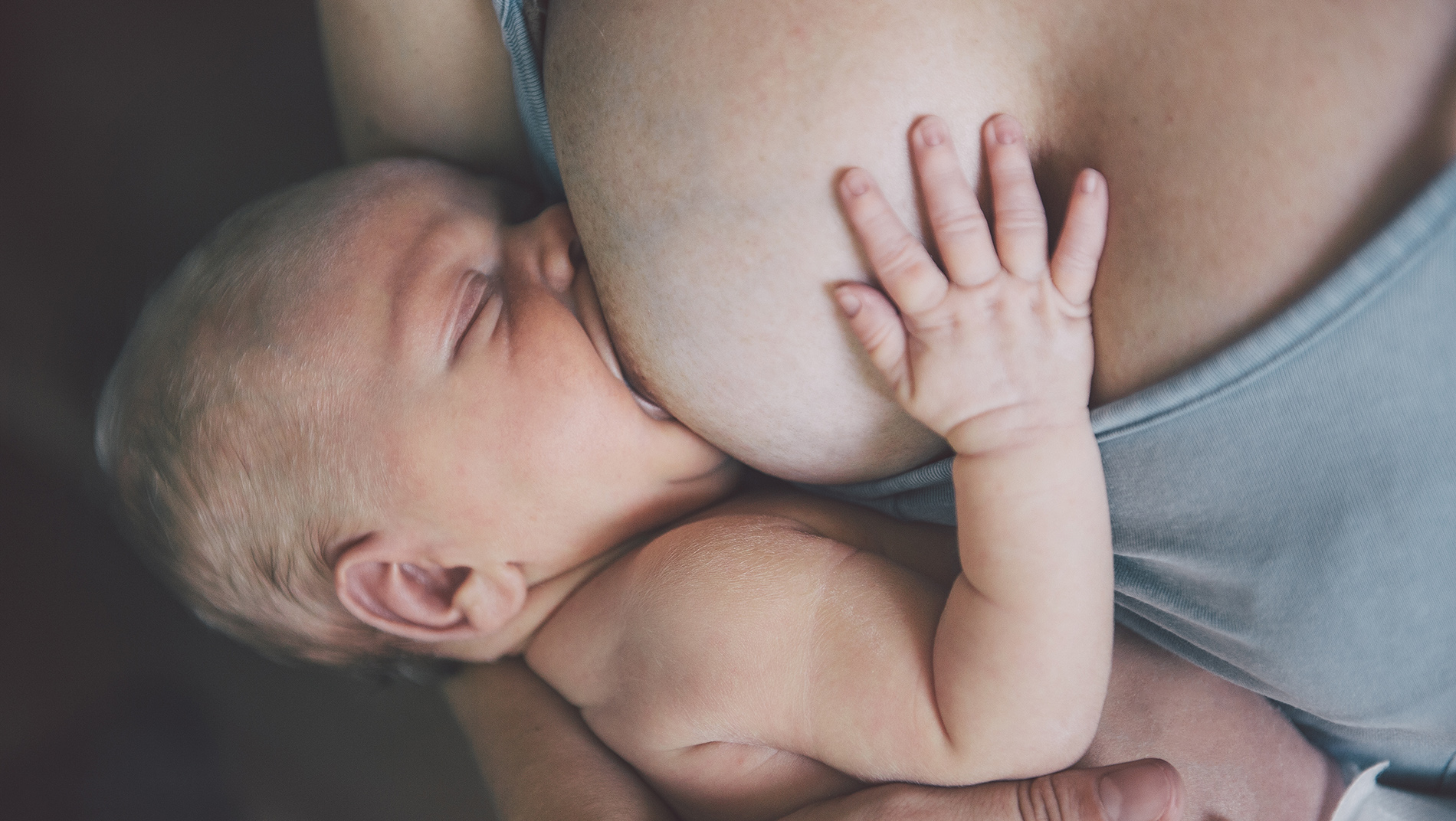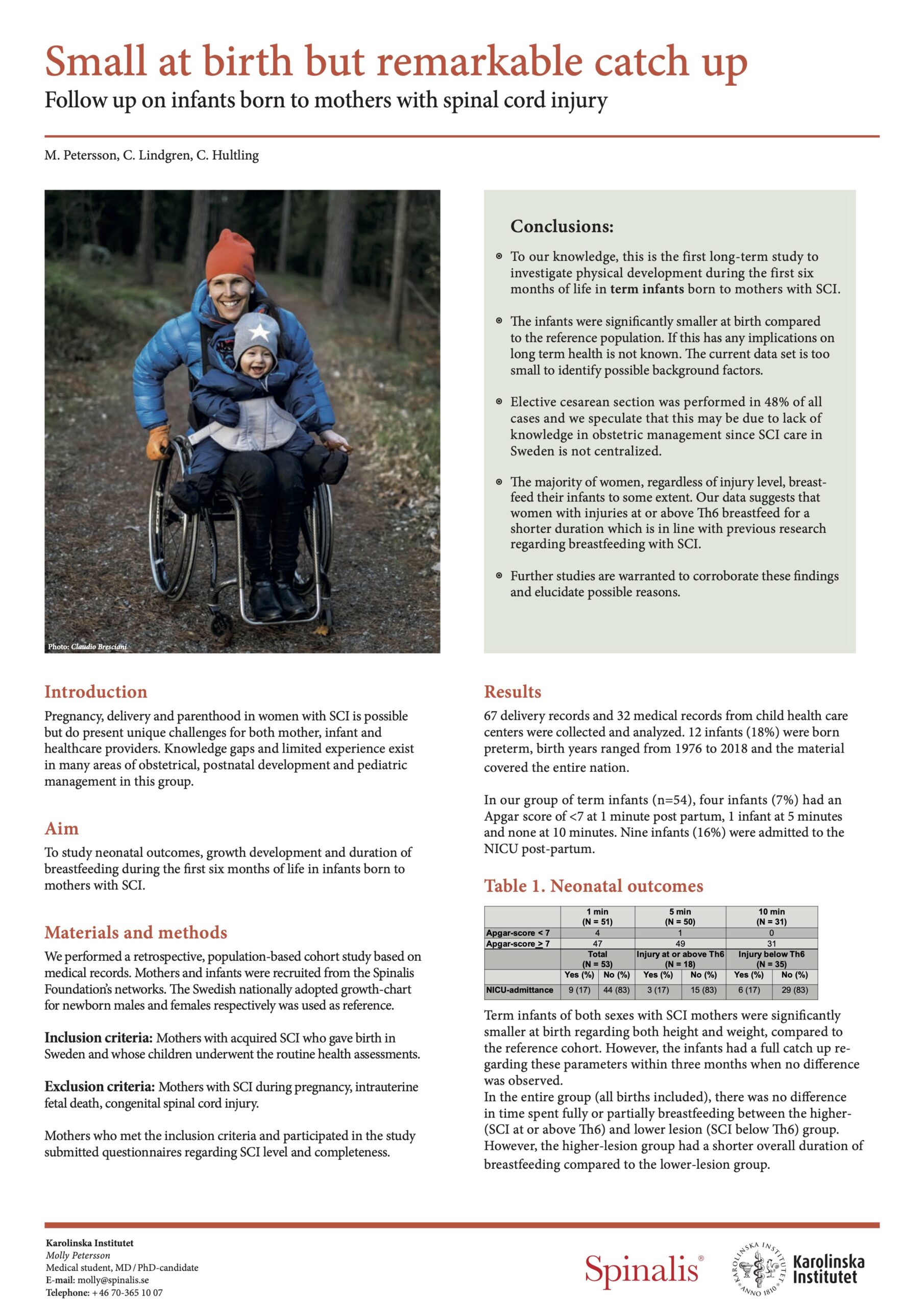Childbirth
Women with spinal cord injury can give birth normally (vaginal delivery), just like any other woman. Also as with other women, circumstances may sometimes require a cesarean section. Labor and delivery are often quick since body muscles do not offer much resistance. If complications should arise, they usually affect the mother rather than the child.
In most cases a woman with spinal cord injury can give birth normally (vaginally), unless complications arise during pregnancy or delivery. Prior to delivery a doctor must assess whether vaginal delivery is possible. Potential obstacles include severe spasticity, new bone formation in soft tissues around joints below the level of injury (heterotopic ossification), or hip joint contractures.
Labor and delivery are often faster and less painful since body muscles do not offer much resistance. The uterus is supplied by nerves from the autonomic nervous system. That means that the nerve impulses in the uterus are not controlled by the central nervous system in the spinal cord, but are governed by a different part of the nervous system under its own control. That is why a woman with spinal cord injury can give birth without voluntary muscle contractions. If the abdominal muscles are not active enough to push the baby all the way out, the birthing process can be assisted through other means, such as vacuum extraction. If the level of spinal cord injury is below T12, uterine contractions will be felt normally.
Prior to delivery, the uterus trains for the event through contractions, known as Braxton Hicks contractions. A contraction may be experienced as tightness in the lower abdomen or as back pain. If the level of injury is above T10, these contractions may not be felt. If Braxton Hicks contractions occur early in pregnancy, there is some risk that the uterine cervix may shorten and thereby dilate (open) before the baby reaches term. If concern arises that contractions are coming too early in pregnancy or too often, the woman should contact her midwife or doctor.

How do you know when labor starts?
Pregnant women with spinal cord injury may find it difficult to know when they are going into labor. A clear sign that labor contractions have started is that the uterus tightens and appears to rise. You can see this by looking and feeling the stomach. Unlike Braxton Hicks contractions, labor contractions come at regular intervals. You may want to ask a midwife or doctor for further information. Other signs that labor has started include increased spasticity, shortness of breath or autonomic dysreflexia. Assessing the strength and intensity of contractions may be difficult. Women with spinal cord injury who feel uncertain about whether labor has begun should contact the labor and delivery department at the hospital to be checked.
Premature delivery
Several sources state that women with spinal cord injury are at greater risk of premature delivery, defined as prior to week 37. However, we have not found any source that explains why there is an increased risk of premature delivery.
It is important to treat all urinary tract infections with antibiotics, even when they are asymptomatic. The reason is that in pregnancy, urinary tract infections may often travel back up through the ureters into the kidney and cause infection there. A kidney infection causes the release of inflammatory substances throughout the abdominal cavity that can trigger premature labor.
Autonomic dysreflexia
People with spinal cord injury above the T6-8 level are at greater risk of developing autonomic dysreflexia, though some cases have also been reported from lower level injuries. Autonomic dysreflexia is a condition that results in extremely high blood pressure due to overactivity in the autonomic nervous system. Symptoms may include headache, sweating, mottled skin and nausea.
Autonomic dysreflexia often results from pain stimulation and may therefore occur during labor. Pain management, in this case epidural anesthesia, may prevent this condition. For this reason, epidural anesthesia may be appropriate in a woman with complete spinal cord injury even though should she may not be able to feel the contractions. It is important for the obstetrician to be aware of this problem and prescribe analgesics when appropriate. Prior to delivery it may be wise to check with an anesthesiologist to make sure there are no contraindications to epidural anesthesia.
Effect on lungs
Lung capacity is affected by normal pregnancy. If lung capacity is also compromised because of spinal cord injury, temporary treatment with supplementary oxygen during labor may be a good idea. If the spinal cord injury is in the upper thoracic or cervical region it may become necessary to induce labor at an earlier stage to limit the adverse effects on lung capacity.
Risk of blood clot
Blood-thinning medications are often prescribed during pregnancy since spinal cord injury and pregnancy may both increase the risk of developing blood clots. Some women may need to continue treatment with blood thinners after delivery depending on the level of injury and the mother’s condition.

Anemia
Several studies suggest that women with spinal cord injury are at greater risk of developing anemia (low blood count) during pregnancy, but it is also important to continue to monitor blood count after delivery. If treatment with iron tablets is prescribed, it should be kept in mind that these may cause constipation. To avoid this problem, iron supplements may need to be given intravenously instead of by mouth.
Pressure ulcers
Low blood count and changes in hormonal balance both increase the risk of pressure ulcers. During pregnancy and delivery pressure-relieving pillows, cushions and mattresses should be used. Additional pillows may be helpful to support women who may have poor trunk balance. In the joy of the moment with the arrival of the newborn baby it is easy for the mother to forget to check her own body. Following delivery it is wise to relieve skin pressure and check for development of any pressure ulcers.
Breastfeeding
Yes, you can nurse even if you have a high-level spinal cord injury. Studies show that breastfeeding can be affected if you have an injury above Th6 as the communication between the breasts and midbrain does not work correctly.
The mother may need a little more support to find a good position for breastfeeding that works for both herself and the baby. Many find that a nursing cushion helps. People who lack sensation in their breasts should be a little extra cautious since skin lesions can easily occur. You should also check that the breast tissue does not become hard, which may be a sign of a blocked duct.
The Canadian SCIRE Project, Spinal Cord Injury Research Evidence, together with i.a. The Spinalis Foundation has produced guidelines regarding breastfeeding for mothers with spinal cord injury. Read the guidelines here.

Preparations
Besides the usual items that midwives and other parents recommend before packing to go to the hospital, there are a few other things to consider. If possible, the parents-to-be should visit the maternity ward to see how accessible it is. Here are a few suggestions:
Things to consider prior to delivery:
- Sliding board
- Can the hospital bed be adjusted to the proper height for transfer
- Large delivery room to allow wheelchair movement
- The bassinet in which the baby is wheeled around meets the needs of a mother with spinal cord injury
- Handicap accessible toilet adjacent to delivery room
- Bring all supplies needed to use the toilet throughout the hospital stay
- Extra wheelchair cushion (and perhaps an extra backrest cover)
Things to consider before your maternity ward stay:
- That your partner can spend the night
- Sufficiently comfortable bed
- Adjoining bathroom
This text was reviewed for medical accuracy by Karin Pettersson, consultant, Obstetrics, Department of Women’s and Children’s Health, Karolinska University Hospital Huddinge.
Remarkable catch up

Read about Molly Khalili study ”Pregnancy, delivery, and neonatal outcomes among women with spinal cord injury in Sweden 1997-2015: A population-based cohort study”. The aim of this study was to describe the rate of pregnancy in spinal cord injured women in Sweden as well as pregnancy, delivery, and neonatal outcomes.
